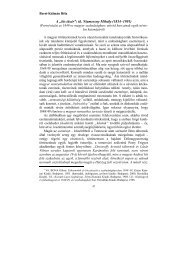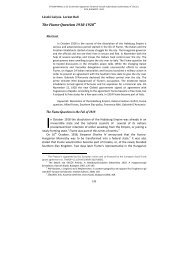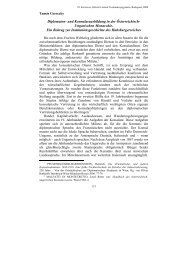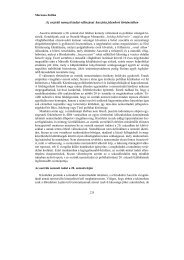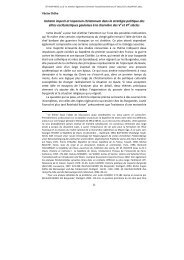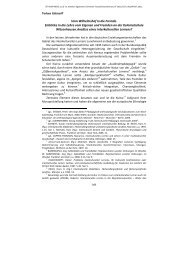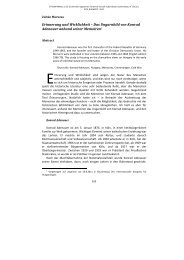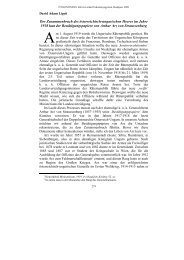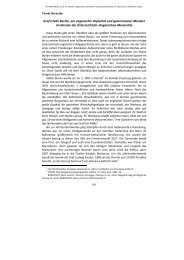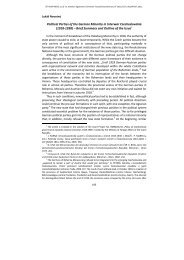Historical Films as Tools of Communist Propaganda.
Historical Films as Tools of Communist Propaganda.
Historical Films as Tools of Communist Propaganda.
Create successful ePaper yourself
Turn your PDF publications into a flip-book with our unique Google optimized e-Paper software.
ÖT KONTINENS, az Új- és Jelenkori Egyetemes Történeti Tanszék tudományos közleményei, N o 2011/1.<br />
ELTE, BUDAPEST, 2012.<br />
Martin Kovář<br />
<strong>Historical</strong> <strong>Films</strong> <strong>as</strong> <strong>Tools</strong> <strong>of</strong> <strong>Communist</strong> <strong>Propaganda</strong>.<br />
Contribution to the History <strong>of</strong> the Czechoslovak Cinematography at the<br />
Turn <strong>of</strong> the 1940s and 1950s<br />
Abstract<br />
The <strong>Communist</strong> rule manifested itself in the Czechoslovak cinematography in<br />
the most symptomatic way especially in the 1940s-1950s, mainly while shooting<br />
spectacular historical films that were supposed to become the important tool <strong>of</strong><br />
the <strong>Communist</strong> propaganda and strengthen the position <strong>of</strong> the <strong>Communist</strong> Party.<br />
In the years 1954-1956 the Czech director Otakar Vávra presented in his grandiose<br />
and very expensive movies, so called „Hussite Trilogy”, to the f<strong>as</strong>cinated people<br />
not only the picture <strong>of</strong> the national heroes fighting against „German aggressors”<br />
from the 15 th century (obvious analogy with the struggle against Germans during<br />
the Second World War), but, at the same time and mainly, the fact that the Czech<br />
and Slovak „common (or ordinary) people”, the predecessors <strong>of</strong> the future<br />
<strong>Communist</strong>s, raised up against the German aristocracy and against the corrupted<br />
Catholic Church already many centuries ago. His works are, according to many<br />
experts, the best example <strong>of</strong> the <strong>Communist</strong> propaganda in the big screen during<br />
the first ph<strong>as</strong>e <strong>of</strong> the <strong>Communist</strong> rule in this country.<br />
Keywords: <strong>Communist</strong> Czechoslovakia, Nationalized Cinematography,<br />
<strong>Communist</strong> Ideology and <strong>Propaganda</strong>, Otakar Vávra, Hussite Movement, „Hussite<br />
Trilogy”<br />
n the <strong>Communist</strong> Czechoslovakia (1948-1989) the cinematography had – in<br />
comparison with Western countries – a somewhat special position. „On the<br />
one hand, the whole film industry became nationalized and the <strong>Communist</strong><br />
authorities had the whole art <strong>of</strong> film under direct supervision, which manifested<br />
itself mainly in strict censorship; on the other hand, the <strong>Communist</strong> regime w<strong>as</strong><br />
fairly broad-minded <strong>as</strong> to <strong>of</strong>ten support very ambitious and costly projects <strong>of</strong> the<br />
authors who were willing to cooperate with them under the new conditions, i.e.<br />
within the barriers <strong>as</strong> set by the new ones in power.” 1<br />
I<br />
As I will show on the particular examples, the <strong>Communist</strong> rule manifested itself<br />
in the Czechoslovak cinematography in the most symptomatic way especially in<br />
the second half <strong>of</strong> the 1940s and at the first half <strong>of</strong> the 1950s, among others while<br />
shooting spectacular historical films that were supposed to become the important<br />
1 Cf. ŠKVORECKÝ, J., Všichni ti bystří mladí muži a ženy. Osobní historie českého filmu, Praha 1991,<br />
45 ff. To the general context cf. KOVÁŘ, M., Artist versus Dictatorship. Some Remarks on the Reflection<br />
<strong>of</strong> Spanish Anti-Frankist’s Work in the <strong>Communist</strong> Czechoslovakia, Prague Papers on the History <strong>of</strong><br />
International Relations, Vol. 15, 2010/1, mainly 155-158.<br />
177
Martin Kovář: <strong>Historical</strong> <strong>Films</strong> <strong>as</strong> <strong>Tools</strong> <strong>of</strong> <strong>Communist</strong> <strong>Propaganda</strong><br />
tool <strong>of</strong> the <strong>Communist</strong> propaganda and strengthen the position <strong>of</strong> the Party<br />
striving to get the power, or the Party that took grip <strong>of</strong> this power in February<br />
1948 for more than forty long years.<br />
The end <strong>of</strong> the Second World War in 1945 brought fundamental changes into<br />
the lives <strong>of</strong> inhabitants <strong>of</strong> most European countries. The Czechoslovak Republic<br />
w<strong>as</strong> not an exception. Its territory having been liberated by the Red Army and<br />
that’s why it found itself in the Soviet sphere <strong>of</strong> influence with all the<br />
consequences that followed. Although the majority <strong>of</strong> Czechs and Slovaks were<br />
dreaming about a democratic Czechoslovakia, which could have – <strong>as</strong> they saw it –<br />
become a sort <strong>of</strong> „bridge between the E<strong>as</strong>t and the West” in the bipolar world<br />
that w<strong>as</strong> just coming into existence, the <strong>Communist</strong> rulers in Moscow <strong>as</strong> well <strong>as</strong><br />
those at Prague had different views <strong>of</strong> the future development. 2<br />
In their struggle for seizing power in the country a key role w<strong>as</strong> played by<br />
propaganda, its part being – logically – the film <strong>as</strong> well. 3 Thus it w<strong>as</strong> very important<br />
that <strong>as</strong> early <strong>as</strong> on 11 August 1945 Edvard Beneš, President <strong>of</strong> the Republic, signed<br />
a decree to provide the nationalization <strong>of</strong> the Czechoslovak film. 4 On the strength<br />
<strong>of</strong> it the state started to run the film studios, and became a sole film producer,<br />
importer, exporter and distributor in Czechoslovakia, <strong>as</strong> well <strong>as</strong> an exclusive<br />
guarantor <strong>of</strong> public film performances. If we add establishing a film college, the so<br />
called Filmová akademie múzických umění (Film Academy <strong>of</strong> Performing Arts;<br />
FAMU, 1946), hectic building <strong>of</strong> modern technical facilities, an incre<strong>as</strong>ing number<br />
<strong>of</strong> cinem<strong>as</strong> and projection halls to it, it w<strong>as</strong> obvious that the <strong>Communist</strong>s credited<br />
the cinematography with a significant role in their plans.<br />
The <strong>Communist</strong> Party <strong>of</strong> Czechoslovakia had a head start because <strong>of</strong> the fact<br />
that it had since 1945 been taking the most important position in film industry <strong>of</strong><br />
all the political parties. Moreover, the <strong>Communist</strong>s had the Ministry <strong>of</strong> Information<br />
under control, the head <strong>of</strong> which – Václav Kopecký 5 – appointed his fellow partyman,<br />
poet Vítězslav Nezval 6 <strong>as</strong> head <strong>of</strong> the Cinematography Section. The leading<br />
2 Cf. KAPLAN, K., Pravda o Československu 1945-1948, Praha 1990, mainly 5-23; KUKLÍK, J. –<br />
NĚMEČEK, J., Osvobozené Československo očima britské diplomacie, Praha 2010, p<strong>as</strong>sim.<br />
3 The second important part <strong>of</strong> the <strong>Communist</strong> propaganda w<strong>as</strong> fiction, including belles-lettres. Cf.<br />
KNAPÍK, J., Únor a kultura: Sovětizace české kultury, 1948-1950, Praha 2004, p<strong>as</strong>sim; KNAPÍK, J., „Do půl<br />
roku budeme mít úplně jinou literaturu.” Literární život let 1948-1949 v iluzích kulturních politiků, Acta<br />
Historica Universitatis Silesianae Opaviensis, Děje, iluze a realita v dějinách, Vol. 2009. N o 2, 117-124;<br />
KLUSÁK, Alexej, Kultura a politika v Československu 1945-1956, Praha 1998, p<strong>as</strong>sim.<br />
4 Cf. Decree <strong>of</strong> the President <strong>of</strong> Republic no. 50/1945 Sb.; KUKLÍK, J., Mýty a realita takzvaných<br />
Benešových dekretů. Dekrety prezidenta republiky 1940-1945, Praha 2002; BLUMENWITZ, D., Benešovy<br />
dekrety z roku 1945 z hlediska mezinárodního práva, Střední Evropa, Vol. 8, N o 26, 1992, 22-30.<br />
5 Václav Kopecký (1897-1961), Czech <strong>Communist</strong> politician; cf. NIKLÍČEK, L., Ideolog a praktik<br />
československého stalinismu, Dějiny a souč<strong>as</strong>nost, Vol. 12 (1990), N o 3, 46-50; KAPLAN, K. – KOSATÍK,<br />
P., Gottwaldovi muži, Praha – Litomyšl 2004, KAPLAN, K., Mocní a bezmocní, Toronto 1989.<br />
6 Vítězslav Nezval (1900-1958), Czech avant-garde poet and, later, an active member <strong>of</strong> the<br />
<strong>Communist</strong> party, „w<strong>as</strong> supposed to be the typical example <strong>of</strong> ‘a new creative intelligentsia’ in so<br />
called ‘people’s democracy’ for whom the <strong>Communist</strong> Party <strong>of</strong> Czechoslovakia had been calling for a<br />
share <strong>of</strong> managing the common weal.” Cf. KNAPÍK, J., Filmová aféra L. P. 1949, Iluminace, 12, 4 (40),<br />
2000, 97-120.<br />
178
ÖT KONTINENS, az Új- és Jelenkori Egyetemes Történeti Tanszék tudományos közleményei, N o 2011/1.<br />
ELTE, BUDAPEST, 2012.<br />
representatives <strong>of</strong> this ministry claimed that should film art be really effective <strong>as</strong> a<br />
means <strong>of</strong> propaganda, it must be appealing to the audience, and so it w<strong>as</strong> not<br />
possible to only shoot schematic (or sketchy) films à la socialist realism b<strong>as</strong>ed upon<br />
the Soviet model. 7 On the other hand, the Cultural propaganda section <strong>of</strong> the<br />
Central Committee <strong>of</strong> the <strong>Communist</strong> Party <strong>of</strong> Czechoslovakia (the so called<br />
Agitprop) headed by Gustav Bareš, 8 editor-in-chief <strong>of</strong> a party periodical called<br />
Tvorba, that w<strong>as</strong> backed by General Secretary <strong>of</strong> the <strong>Communist</strong> Party Rudolf<br />
Slánský 9 were <strong>of</strong> the opinion that the „ideological purity <strong>of</strong> a work” must be<br />
emph<strong>as</strong>ized, even if the film production might be less attractive for the audience.<br />
The result <strong>of</strong> this dispute 10 w<strong>as</strong> that one could watch both commercial, nonpolitical<br />
films in principle the directors <strong>of</strong> which did not manipulate with the<br />
audience – should they do so, they did it in a very skilful and non-violent way – <strong>as</strong><br />
well <strong>as</strong> films that would overtly present the communist view <strong>of</strong> the world <strong>as</strong> the<br />
only right one and that would show the <strong>Communist</strong> Party <strong>as</strong> the only guarantor <strong>of</strong><br />
progress and optimistic future <strong>of</strong> the nation.<br />
As a result, the <strong>Communist</strong>s could during their coup d’état in February 1948<br />
lean on not only a brilliantly working party structure, strong power b<strong>as</strong>e and – l<strong>as</strong>t<br />
but not le<strong>as</strong>t – on being effectively aided by the so called Soviet advisers, de facto<br />
agents <strong>of</strong> the Soviet intelligence service, but also on a relatively strong support <strong>of</strong><br />
the public whose inclination to the <strong>Communist</strong> ideology could be not<br />
insignificantly <strong>as</strong>cribed to the film industry which had already been partly taken<br />
over by them. 11<br />
Within the first three years after the takeover <strong>of</strong> power the <strong>Communist</strong>s would<br />
strive to take total control <strong>of</strong> all the structures <strong>of</strong> the film industry, which had to<br />
satisfy their needs fully and completely. Thus, <strong>as</strong> early <strong>as</strong> in 1949 they established<br />
two important bodies – the so called Filmová rada (Film Council; under the<br />
patronage <strong>of</strong> minister Kopecký), 12 and Ústřední dramaturgie (Central Dramaturgy;<br />
in fact managed by Gustav Bareš), which had the same aim but – like in the p<strong>as</strong>t –<br />
different ide<strong>as</strong> <strong>of</strong> how to achieve this. In an effort to take the Czechoslovak film<br />
under <strong>Communist</strong> control, a significant role w<strong>as</strong> played by the so called Filmová<br />
7<br />
Cf. LINHART, L., Co očekává film, in: Tvorba, č. 17, 1948, s. 268; KOPECKÝ, V., Referát pro Sjezd<br />
národní kultury (Sbírka dokumentů), Praha 1948, 131.<br />
8<br />
Cf. KNAPÍK, J., Kdo spoutal naši kulturu (Portrét stalinisty Gustava Bareše), Přerov 2000.<br />
9<br />
Rudolf Slánský (1901-1952), Czech <strong>Communist</strong> Politician, General Secretary <strong>of</strong> the <strong>Communist</strong><br />
Party (1945-1951), in 1952 executed during the political purges <strong>of</strong> the <strong>Communist</strong> Party. Cf. KAPLAN, K.,<br />
Zpráva o zavraždění generálního tajemníka, Praha 1992.<br />
10<br />
Cf. DRÁPALA, M., Iluze jako osud, in: Soudobé dějiny, Vol. 3. (1996), No. 2-3, 175-218; KUSÁK, A.,<br />
Kultura a politika v Československu 1945-1956, Praha 1998, 286-289; KNAPÍK, J., Únor a kultura.<br />
Sovětizace české kultury 1948-1950, Praha 2004, 217-236.<br />
11<br />
EISMANN, Š., Film a kulturní politika 1945-1952, Praha 1999, p. 90, manuscript, Národní<br />
filmový archiv v Praze; POKORNÝ, J., Odbory a znárodněný film, Filmový sborník historický, Vol. 3,<br />
Praha 1992, 215.<br />
12<br />
Cf. STRUSKOVÁ, E. (ed.), Knihu džunglí jsem nenapsal. Rozhovor se Svetozarem Vítkem,<br />
Iluminace, Vol. 12 (2000), No. 4 (40), 124; CÍSAŘ, Č., Člověk a politik (Kniha vzpomínek a úvah), Praha<br />
1998, 88; VÁVRA, O., Podivný osud režiséra, Praha 1994, 157.<br />
179
Martin Kovář: <strong>Historical</strong> <strong>Films</strong> <strong>as</strong> <strong>Tools</strong> <strong>of</strong> <strong>Communist</strong> <strong>Propaganda</strong><br />
rezoluce (Film Resolution; the whole title: Za vysokou ideovou a uměleckou úroveň<br />
československého filmu – For the High Ideological and Artistic Standard <strong>of</strong> the<br />
Czechoslovak Film) <strong>of</strong> April 1950, 13 which also resulted in, apart from introducing<br />
ideological control and censorship from the side <strong>of</strong> party bodies, coming the<br />
Československý státní film (Czechoslovak State Film) into existence. 14 Not only did<br />
the Film studio <strong>of</strong> Barrandov go within this institution but also all the other film<br />
institutions in Czechoslovakia, including the production <strong>of</strong> short, news,<br />
documentary, educational films and cartoons, the film studio <strong>of</strong> Gottwaldov, the<br />
Central Film Lending Library etc. 15<br />
The year <strong>of</strong> 1950 saw the first check-ups and purges in the film industry, and so<br />
called Socialist Realism had become the only possible art movement. It meant<br />
further reinforcing the ideological control and making hardly any other films than<br />
sketchy and totally conforming to communist ideology. No wonder then that<br />
under such circumstances there were a lot <strong>of</strong> arguments and conflicts among<br />
people working in film industry. The <strong>Communist</strong>s in power would push new, young<br />
authors through, willing to write scripts and make films in accordance with their<br />
directives, where<strong>as</strong> some <strong>of</strong> the older writers and directors would not agree with<br />
such practices and would like to retain in their works the legacy <strong>of</strong> the „interwar<br />
avantgarde”. 16 Therefore, the young artists would blame them for having „rightwing<br />
deviations” and „confining themselves to making commercial films”; the<br />
older ones would, on the contrary, criticize the young for being „excessively<br />
dependent on the <strong>Communist</strong> Party bodies”.<br />
As a result, there were plenty <strong>of</strong> affairs and scandals. Disputes appeared <strong>as</strong><br />
early <strong>as</strong> the film Dva<strong>as</strong>edmdesátka (A Seventy-two) by Jiří Slavíček w<strong>as</strong> shot<br />
(1948), 17 and then mainly with the film Císařův pekař – Pekařův císař (The<br />
Emperor’s Baker – The Baker’s Emperor; 1951). This costume comedy from the<br />
times <strong>of</strong> Roman Emperor Rudolph II, i.e. from the beginning <strong>of</strong> the seventeenth<br />
century, came into being on the initiative <strong>of</strong> Jan Werich, prominent pro-<br />
<strong>Communist</strong> actor, former head <strong>of</strong> the so called Osvobozené divadlo (Liberated<br />
Theatre), and it w<strong>as</strong> being prepared – in Czechoslovakia – <strong>as</strong> an unusual large-scale<br />
enterprise with the budget amounting to an <strong>as</strong>tronomical (at that time) sum <strong>of</strong><br />
13 The resolution w<strong>as</strong> widely popularized. Cf. JIRÁNEK, J., Hudba se učí z rezoluce o filmu,<br />
Tvorba, Vol. 1950, No. 20, 483; GALUŠKA, M. – BOR, V., Kulturní pracovníci k usnesení o filmu,<br />
Lidové noviny, 18. 5. 1950, 5; MAREK, J., Spisovatelé čelem k filmu, Tvorba, Vol. 1950, N o 26,<br />
628 etc.<br />
14 Decree <strong>of</strong> the Czechoslovak Government No. 72/1948 SB. Cf. MÁLEK, J., O čs. státním filmu, Rudé<br />
právo, 27. 4. 1948, 2; the memoir <strong>of</strong> Lubomír LINHART, IN: Jak byl znárodněn čs. film. Svědectví a<br />
dokumenty II, Film a doba, Vol. 11 (1965), N o 3, 131-132.<br />
15 Cf. EISMANN, Š., Osudy spolkových biografů v poválečném Československu, Iluminace, Vol. 11<br />
(1999), N o 1 (36), 53-86; EISMANN, Š., Film a kulturní politika..., 91; HAVELKA, J., Československé filmové<br />
hospodářství 1945-1950, Praha 1970, 29.<br />
16 KNAPÍK, J., Únor a kultura..., 236-245.<br />
17 Cf. for example Český hraný film III (1945-1960), Praha 2001, 77-78; Pracující odsoudili<br />
„Dva<strong>as</strong>edmdesátku”, Práce, 1. 12. 1948, 6; Kritika „Dva<strong>as</strong>edmdesátky”, Práce, 3. 12. 1948, 3; Dělníci<br />
proti „Dva<strong>as</strong>edmdesátce”, Mladá fronta, 2. 12. 1948, 3.<br />
180
ÖT KONTINENS, az Új- és Jelenkori Egyetemes Történeti Tanszék tudományos közleményei, N o 2011/1.<br />
ELTE, BUDAPEST, 2012.<br />
nearly thirty million Czech Crowns. 18 The dispute in question seemingly concerned<br />
mainly the post <strong>of</strong> director – where<strong>as</strong> Gustav Bareš insisted on Jiří Krejčík, Jan<br />
Werich supported by minister Kopecký managed to put through Martin Frič – it<br />
w<strong>as</strong> in fact a collision between two influential Party groups trying to enforce their<br />
influence in the Czechoslovak State Film. 19 The collision ended with the victory <strong>of</strong><br />
Werich and Kopecký; Bareš labelled the film The Emperor’s Baker <strong>as</strong> an<br />
„Americano comedy” adding that the „thirty million Crowns it had cost went down<br />
the drain”, but his influence in film industry w<strong>as</strong> in fact over. However, and it is<br />
the most important, these conflicts did not bring any fundamental changes into<br />
the situation in the Czechoslovak cinematography: its tendency having been<br />
decided upon before.<br />
As far <strong>as</strong> the film production itself is concerned, the Czechoslovak<br />
cinematography w<strong>as</strong> in the first post-war years, i.e. before the <strong>Communist</strong> coup<br />
d’état <strong>of</strong> February 1948, dominated by two themes: 1) films b<strong>as</strong>ed on popular<br />
literary works, for example Týden v tichém domě (A Week in a Quite House by Jiří<br />
Krejčík; 1947), Čapkovy povídky (Čapek’s Stories by Martin Frič; 1947), Krakatit<br />
(Krakatit by Otakar Vávra; 1948); 2) films dealing with the recent war p<strong>as</strong>t, for<br />
example Uloupená hranice (Stolen Frontier by Jiří Weiss; 1947), Ves v pohraničí (A<br />
Village in the Borderland by Jiří Krejčík; 1948), Daleká cesta (A Long Way Off by<br />
Alfréd Radok; 1948) or Němá barikáda (Numb Barricade by Otakar Vávra; 1949). 20<br />
After the February coup d’état many <strong>of</strong> the mentioned films were criticized for<br />
their openness and disloyalty to <strong>Communist</strong> ideology.<br />
After February 1948 and after complete takeover <strong>of</strong> the Czechoslovak State<br />
Film by the <strong>Communist</strong>s in fact only four types <strong>of</strong> films had until mid-fifties been<br />
made. Firstly, these were „comedy propaganda films” boosting the merits <strong>of</strong> the<br />
new regime in comparison with the old, „bourgeois republic”, extolling<br />
enthusi<strong>as</strong>tic ardour, socialist competitiveness and the best workers: <strong>as</strong> a cl<strong>as</strong>sic<br />
example <strong>of</strong> such kind <strong>of</strong> films may serve a musical with a symptomatic name Zítra<br />
se bude tančit všude (Tomorrow All the Country will be Dancing; by Vladimír Vlček<br />
in 1952) or trade union comedies Dovolená s Andělem (A Holiday with Angel by<br />
Bořivoj Zeman; 1952) and Anděl na horách (Angel in the Mountains”, again by<br />
Bořivoj Zeman; 1955). Secondly, there were the so called „commercial films <strong>of</strong> a<br />
new type”, which seemed to be free <strong>of</strong> <strong>Communist</strong> propaganda but in reality they<br />
did impact on the audience by more sophisticated media (for example Pytlákova<br />
schovanka (Poacher’s Foster Daughter by Martin Frič; 1949). The third type <strong>of</strong><br />
„post-February films” w<strong>as</strong> formed by „political and espionage dram<strong>as</strong>” the topics<br />
<strong>of</strong> which covering conflicts between advocates <strong>of</strong> the „new world”, i.e. the<br />
<strong>Communist</strong>s and their sympathizers, and overt or covert advocates <strong>of</strong> the „old<br />
18<br />
HAVELKA, J., Kronika našeho filmu (1898-1965), Praha 1967, 54.<br />
19<br />
KUSÁK, A., op. cit., 289-298.<br />
20<br />
Cf. KOVÁŘ, M. – SOUKUP, J., How to Kill Heydrich. Some Remarks to the Czechoslovak<br />
Contribution to the Defeat <strong>of</strong> Nazi Germany in the World War II on the Big Screen, The Twentieth<br />
Century – Dvacáté století, Vol. 5 (2010), N o 2, 107-123.<br />
181
Martin Kovář: <strong>Historical</strong> <strong>Films</strong> <strong>as</strong> <strong>Tools</strong> <strong>of</strong> <strong>Communist</strong> <strong>Propaganda</strong><br />
order”: and it w<strong>as</strong> their disclosing and „just punishing” that those films were<br />
mainly about; <strong>as</strong> an example may be mentioned the film called Únos (Kidnapping)<br />
by the director duo <strong>of</strong> Ján Kadár and Elmar Klos (1952). 21<br />
In all the three film types we can find the same characters – ideal bearers <strong>of</strong><br />
explicitly defined social roles: 1) A young male member <strong>of</strong> the Youth <strong>Communist</strong><br />
Movement or the <strong>Communist</strong> Party, or, <strong>as</strong> the c<strong>as</strong>e may be, a young emancipated<br />
girl (woman), who do not mind overcoming obstacles when building a „new<br />
society” and who by means <strong>of</strong> their enthusi<strong>as</strong>m and faith in a „better world”<br />
inspire the others; 22 instead <strong>of</strong> a young man or woman there may appear a wise,<br />
experienced Party Official who is able to lead by his example the others; 2) His<br />
elder fellow worker, friend or relative, who is at first rather sceptical about „new<br />
things” but after all will come to understand the merits <strong>of</strong> the new regime and get<br />
on the band waggon; 23 3) A lingering intellectual understanding the „inevitability”<br />
<strong>of</strong> the changeover from the „old” to the „new” type <strong>of</strong> society only with difficulty;<br />
4) A comic, b<strong>as</strong>ically harmless character <strong>of</strong> a “reactionary” who will not come to<br />
understand where „progress” in society is but who at the same time is not an<br />
active evil-doer. 5) An overt enemy, usually a former factory owner, member <strong>of</strong><br />
one <strong>of</strong> the political parties <strong>of</strong> the pre-war „bourgeois republic”, collaborating with<br />
German Occupants during the Second World War and now cooperating with<br />
„German Revanchists”, or, <strong>as</strong> the c<strong>as</strong>e may be, a spy serving „American<br />
Imperialism”; his disclosure and punishment is a necessary part <strong>of</strong> each film in<br />
which such a character turns up.<br />
The l<strong>as</strong>t, fourth type <strong>of</strong> „post-February films” w<strong>as</strong> made up by historical ones.<br />
As many film historians say, these films represented the most characteristic type<br />
at the turn <strong>of</strong> the 1940s and 1950s in the <strong>Communist</strong> Czechoslovakia. It w<strong>as</strong> this<br />
very type <strong>of</strong> films where the „new political situation” could be viewed most<br />
distinctly. The <strong>Communist</strong> interpretation <strong>of</strong> national history w<strong>as</strong> b<strong>as</strong>ed upon the<br />
way Czech National Revivalists <strong>of</strong> the 19 th century interpreted it, mainly upon the<br />
work <strong>of</strong> historian František Palacký who saw the acme <strong>of</strong> national rise and effort in<br />
the so called Hussite Movement <strong>of</strong> the first half <strong>of</strong> the 15 th century when the<br />
Czech Lands would successfully defy the pressure from the side <strong>of</strong> the German<br />
Emperor and Rome, who wanted to subject the country in which a radical protoreformist<br />
movement originating from the teachings by Jan Hus, M<strong>as</strong>ter <strong>of</strong> Prague<br />
University, had spread around. 24 Thus, among the most typical historical films <strong>of</strong><br />
21 Ján Kadár (1918-1979) and Elmar Klos (1910-1993), Slovak and Czech film writers and directors,<br />
famous mainly because <strong>of</strong> their film Smrť sa volá Engelchen (Death Is Called Engelchen; 1963) and an<br />
Oscar-Winning film Obchod na korze (The Shop on Main Street; 1965).<br />
22 As an example may be mentioned Mirek Anděl, his girlfriend Věra and two <strong>of</strong> their friends from<br />
the films A Holiday with Angel and Angel in the Mountains.<br />
23 It is in fact Gustav Anděl (Gustav Angel) from the above mentioned films. Anděl (Angel) is a<br />
prototype <strong>of</strong> „old grumpy guy” who, however, understand that the <strong>Communist</strong>s are the guarantors <strong>of</strong><br />
the best future for Czechoslovakia.<br />
24 PALACKÝ, F., Dějiny národa českého v Čechách i v Moravě, Vol. III (1403-1439) and IV(1439-1471).<br />
The modern interpretation <strong>of</strong> the Hussite Movement cf. mainly ŠMAHEL, F., Husitská revoluce, Vol. I-IV,<br />
182
ÖT KONTINENS, az Új- és Jelenkori Egyetemes Történeti Tanszék tudományos közleményei, N o 2011/1.<br />
ELTE, BUDAPEST, 2012.<br />
that time are the ones by director Otakar Vávra, referred to <strong>as</strong> the „Hussite<br />
Trilogy” – Jan Hus (Jan Hus; 1954), Jan Žižka (Jan Žižka; 1955) and Proti všem<br />
(Against All; 1956) the l<strong>as</strong>t <strong>of</strong> which being b<strong>as</strong>ed on the novel by Czech writer Alois<br />
Jirásek (see also the note 29). 25<br />
Having lived to be a hundred years old this year, Otakar Vávra w<strong>as</strong> born in<br />
February 1911 in the E<strong>as</strong>t Bohemian town <strong>of</strong> Hradec Králové. He started to make<br />
films after architecture studies at universities <strong>of</strong> Brno and Prague. As early <strong>as</strong> at<br />
the beginning <strong>of</strong> the 1930s he produced a few experimental films and in 1937 he<br />
made his first own film, Filos<strong>of</strong>ská historie (Philosophers’ History), b<strong>as</strong>ed upon by<br />
Alois Jirásek’s novelette. At the time <strong>of</strong> German occupation he would shoot – <strong>as</strong><br />
well <strong>as</strong> his colleagues-directors – a number <strong>of</strong> popular entertaining films, 26 e.g.<br />
Dívka v modrém (A Girl in Blue; 1939) or Pohádka máje (May Fairytale; 1940). 27<br />
After the liberation <strong>of</strong> the Czechoslovakia he tackled more serious topics and w<strong>as</strong><br />
successful with e.g. Krakatit (Krakatit; 1947) b<strong>as</strong>ed upon the novel <strong>of</strong> the same<br />
name by Karel Čapek, Němá barikáda (Numb Barricade; 1949) b<strong>as</strong>ed upon short<br />
stories by Jan Drda, and Nástup (Taking Up; 1953) b<strong>as</strong>ed upon an „agit novel” by<br />
Václav Řezáč. Then the already mentioned „famous” „Hussite trilogy” came.<br />
Ambitious and opportunist Vávra, willing to do everything – without any<br />
exaggeration – for a possibility to make films even in the years <strong>of</strong> the very cruel<br />
<strong>Communist</strong> regime in the first ph<strong>as</strong>e <strong>of</strong> its development (so called „Bloody Years”<br />
1948-1956), realized very well that the historical topics are extremely important<br />
for the <strong>Communist</strong>s who hoped that there is a possibility to influence the thinking<br />
<strong>of</strong> the people through them. The Czech National Revivalists <strong>of</strong> the 19 th century,<br />
mentioned above, and the Czech left wing intellectuals <strong>of</strong> the first half <strong>of</strong> the 20 th<br />
century pointed out especially the national and anti-German character <strong>of</strong> the<br />
Hussite Movement. After February 1948 the <strong>Communist</strong>s left unchanged this<br />
<strong>as</strong>pect because it w<strong>as</strong> very convenient and popular in the post-war years; the<br />
hatred against the Germans, the former occupants, persisted until the break <strong>of</strong> the<br />
1950s and 1960s. However, simultaneously, they presented the Hussites <strong>as</strong> a<br />
movement with a strong social character, <strong>as</strong> a „people’s movement” and <strong>as</strong> a<br />
predecessors <strong>of</strong> the modern <strong>Communist</strong> Party. 28<br />
Praha 1993; ŠMAHEL, F., Husitské Čechy. Struktury, procesy, ideje, Praha 2001. To the modern<br />
interpretation <strong>of</strong> Palacký’s analysis <strong>of</strong> the Hussite movement cf. ŠMAHEL, F. – DOLEŽALOVÁ, E. a kol.,<br />
František Palacký: dějiny a dnešek: 1798-1998, Praha 1999; ŠTAJF, J., František Palacký: život, dílo,<br />
mýtus, Praha 2009.<br />
25 NEJEDLÝ, Z., Film a dílo Aloise Jiráska, Var, Vol. 1949, No. 11-12, pp. 327-328.<br />
26 Cf. KAŠPAR, L., Český hraný film a filmaři za protektorátu. <strong>Propaganda</strong>, kolaborace, rezistence,<br />
Praha 2007; MOTL, S., Mraky nad Barrandovem. Sláva i zatracení českých filmových hvězd v době<br />
protektorátu i v č<strong>as</strong>e poválečných ortel, Praha 2006. To the general context cf. MACDONALD, C. –<br />
KAPLAN, J., Praha ve stínu hákového kříže, Praha 1995.<br />
27 Cf. HAVEL, M. V., Mé vzpomínky, Praha 1993, mainly 421-433.<br />
28 Josef Macek (1922-1991), Czech Communisst historian, known especially because <strong>of</strong> his<br />
interpretation <strong>of</strong> the „Hussite Revolution”. Cf. for example MACEK, J., Husitské revoluční hnutí, Praha<br />
1952; MACEK, J., Tábor v husitském revolučním hnutí I-II, Praha 1952, 1956; MACEK, J., Jan Hus. Studie s<br />
ukázkami Husova díla, Praha 1961.<br />
183
Martin Kovář: <strong>Historical</strong> <strong>Films</strong> <strong>as</strong> <strong>Tools</strong> <strong>of</strong> <strong>Communist</strong> <strong>Propaganda</strong><br />
So Otakar Vávra presented in his grandiose and very expensive movies to the<br />
f<strong>as</strong>cinated people not only the picture <strong>of</strong> the national heroes fighting against<br />
„German aggressors” (obvious analogy with the struggle against Germans during<br />
the Second World War), but, at the same time and mainly, the fact that the Czech<br />
and Slovak „common (or ordinary) people”, the predecessors <strong>of</strong> the future<br />
<strong>Communist</strong>s, raised up against the German aristocracy and against the corrupted<br />
Catholic Church. 29<br />
The conception <strong>of</strong> the „Hussite Trilogy” is, <strong>as</strong> we see, eminently tricky. 30 Its<br />
first part, the film Jan Hus (1954), tells the story from the years 1412-1415, when<br />
the m<strong>as</strong>sive people’s movement against the abuses in the corrupted Catholic<br />
Church, which gained its name according to Jan Hus, M<strong>as</strong>ter <strong>of</strong> the Prague<br />
University, w<strong>as</strong> born in the Czech Lands. Otakar Vávra shows how the Catholic<br />
clergymen invited Hus to the German town <strong>of</strong> Konstanz under a false pretence <strong>of</strong> a<br />
free discussion about the problems regarding the position <strong>of</strong> this Church in the<br />
Czech Lands but after his arriving they tried to force him renounce his opinions.<br />
Hus refuses to do it and is burned to death. The analogy is absolutely apparent.<br />
The corrupted Catholic Church is nobody else than the „bourgeois” West<br />
European Powers, France and Great Britain, which sacrificed the Czechoslovak<br />
Republic in their effort to keep <strong>of</strong>f the war with the Nazi Germany. The Pope John<br />
XXIII and the Roman King Sigismund <strong>of</strong> Luxembourg evoked the imagination <strong>of</strong> the<br />
Nazi Germany Leaders preparing the destruction <strong>of</strong> the weakened Czechoslovak<br />
Republic whose „bourgeois” leaders are not able to protect it. The burning <strong>of</strong> Jan<br />
Hus is, according to Vávra <strong>as</strong> well <strong>as</strong> according to the Czech <strong>Communist</strong>s, the same<br />
thing <strong>as</strong> an occupation <strong>of</strong> the Czechoslovak borderland by the German armies in<br />
the autumn 1938. The verdict <strong>of</strong> the Konstanz’s Council <strong>of</strong> 1415 and the signature<br />
<strong>of</strong> the Munich Treaty <strong>of</strong> 1938 is the same thing and the defeated and humiliated<br />
nation is the result <strong>of</strong> if.<br />
The second part <strong>of</strong> the trilogy, the film Jan Žižka (1955), tells the story from the<br />
Czech history in the years 1419-1420, i.e. from the times when the weak Bohemian<br />
King Wenceslaus IV, surrounded by the traitorous pro-German aristocracy and his<br />
brother, the Roman King <strong>of</strong> Sigismund <strong>of</strong> Luxembourg, longing for the Czech<br />
Crown, is submitting to the pressure <strong>of</strong> the Catholic Church and turned against the<br />
Hussite Movement. In this situation the squire (or the country gentleman) Jan<br />
Žižka <strong>of</strong> Trocnov becomes the new leader <strong>of</strong> the Czech people (the Czech<br />
Hussites). He refused the demands <strong>of</strong> Sigismund demanding for the Bohemian<br />
Crown after the death <strong>of</strong> his brother Wenceslaus in 1419 and leads the Hussite<br />
29<br />
Adding heroic features and popularization <strong>of</strong> the Hussite movement did not only occur in films.<br />
Under the auspices <strong>of</strong> the <strong>Communist</strong> Minister <strong>of</strong> Education Zdeněk Nejedlý (1878-1962) the collected<br />
works by Alois Jirásek, which also – to a certain degree – comprised praising the Hussite movement,<br />
started to publish. These collected works were symptomatically introduced with the quote by the first<br />
Czech <strong>Communist</strong> President Klement Gottwald.<br />
30<br />
An excellent analysis <strong>of</strong> the „Hussite Trilogy” cf. ČORNEJ, P., Husitská trilogie a její dobový ohl<strong>as</strong>,<br />
IN: KOPAL, P. (ed.), Film a dějiny, Praha 2004, 91 ff.<br />
184
ÖT KONTINENS, az Új- és Jelenkori Egyetemes Történeti Tanszék tudományos közleményei, N o 2011/1.<br />
ELTE, BUDAPEST, 2012.<br />
people’s army to the fight against the German Crusaders at the battle <strong>of</strong> Sudoměř.<br />
The final part <strong>of</strong> this film presents the overwhelming victory <strong>of</strong> the Hussites above<br />
the German Crusaders in this battle. The analogy is, again, entirely evident. The<br />
years <strong>of</strong> 1419-1420 are, in fact, the years <strong>of</strong> the Second World War. The weak King<br />
Wenceslaus is nobody else than the representatives <strong>of</strong> the Protectorate Bohemia<br />
and Moravia (for example the protectorate president Emil Hácha), the Catholic<br />
Church and the Emperor Sigismund are the German Nazis, who want to crush the<br />
Czech nation. The victory at the battle <strong>of</strong> Sudoměř is, according to Vávra, the<br />
liberation <strong>of</strong> the Czechoslovakia from the Nazis in the year <strong>of</strong> 1945. It is a glorious<br />
victory, but only a partial victory. The really decisive battle must only come, the<br />
battle over the future form <strong>of</strong> the free Czechoslovakia.<br />
Just this struggle, this crucial battle is the topic <strong>of</strong> the l<strong>as</strong>t part <strong>of</strong> Vávra’s<br />
„Hussite Trilogy”, the film Proti všem (Against All; 1956). The topic is clear: After<br />
the victory at the battle <strong>of</strong> Sudoměř the Roman King Sigismund declared the<br />
Crusade against the „heretic Czech Lands”. However, the Hussites are decided to<br />
fight „against all” for „their thing” and for „their true”, for their vision <strong>of</strong> the<br />
future form <strong>of</strong> the Bohemian Kingdom. The famous victory at the battle <strong>of</strong> Vítkov<br />
<strong>of</strong> 1420, which is the main part <strong>of</strong> this movie, is the decisive condition for a<br />
possibility to create the Kingdom according to their conception. The analogy is,<br />
again, evident. The Hussites, fighting „against all”, are the post-war <strong>Communist</strong>s,<br />
fighting against their enemies in the years 1947-1948. The victory <strong>of</strong> Hussites at<br />
the battle <strong>of</strong> Vítkov, the monumental drop-scene <strong>of</strong> the Vávra’s film epic, evokes<br />
the „victory <strong>of</strong> the working cl<strong>as</strong>s in February 1948”, i.e. the <strong>Communist</strong> coup<br />
d’état and the establishment <strong>of</strong> the Communism in the Czechoslovakia.<br />
As I have already said, the conception <strong>of</strong> Vávra’s „Hussite Trilogy” is very tricky,<br />
very sophisticated. The director chose his topic and the actors 31 immensely carefully.<br />
The Hussite Movement h<strong>as</strong> already had the strong impact in the Czech Lands, it<br />
influenced many generations <strong>of</strong> the Czech people. The Czechs and, partly, the Slovaks<br />
have liked an imagination <strong>of</strong> their „brave grandfathers opposing the whole Western<br />
Europe with the sword in their hands” apart from the fact that the Hussite Movement<br />
had rather negative consequences for the Bohemian Kingdom in the long term. Otakar<br />
Vávra purposely capitalized on this popular imagination in his films. Above all, his<br />
decision to identify the „God’s Fighters” from the first half <strong>of</strong> the 15 th century with the<br />
ruling <strong>Communist</strong>s made from his „Hussite Trilogy” the very effective tool <strong>of</strong> the<br />
<strong>Communist</strong> propaganda, absolutely typical for their approach to the historical topics<br />
and for their exploiting and abusing <strong>of</strong> the historical themes in the cinematography<br />
after February 1948. In the c<strong>as</strong>e <strong>of</strong> the „Hussite Trilogy” it w<strong>as</strong> particularly effective:<br />
not for the whole nation, <strong>of</strong> course, but for a lot <strong>of</strong> people w<strong>as</strong> relatively e<strong>as</strong>y to<br />
believe that the role <strong>of</strong> the Hussites in the 15 th century and the role <strong>of</strong> the <strong>Communist</strong>s<br />
after the Second World War were similar.<br />
31<br />
The portrait <strong>of</strong> the protagonist <strong>of</strong> his „Hussite Trilogy”, an actor Zdeněk Štěpánek, cf. TUNYS, L.,<br />
Zdeněk Štěpánek, Praha 1992, p<strong>as</strong>sim.<br />
185
Martin Kovář: <strong>Historical</strong> <strong>Films</strong> <strong>as</strong> <strong>Tools</strong> <strong>of</strong> <strong>Communist</strong> <strong>Propaganda</strong><br />
Just this w<strong>as</strong> the main aim <strong>of</strong> Vávra’s trilogy, an attempt to convincingly evoke<br />
an impression that the goal <strong>of</strong> the Hussites w<strong>as</strong>, in fact, the same <strong>as</strong> the goal <strong>of</strong> the<br />
<strong>Communist</strong>s, i.e. the fight for „better future for the ordinary people”, despite <strong>of</strong><br />
the hostility <strong>of</strong> the Catholic Church and German Roman Emperor in the 15 th<br />
century or, if you like, despite the hostility <strong>of</strong> „the treacherous, perfidious<br />
Imperialist West” after the Second World War. If we take into account that Vávra<br />
w<strong>as</strong> very capable director and that his trilogy w<strong>as</strong> made very skilfully, no doubt<br />
that his first „opus magnum” w<strong>as</strong> successful and that ruling <strong>Communist</strong>s were<br />
fully satisfied.<br />
Respect to this fact there is no surprise that Vávra gained his „special reward”<br />
from the <strong>Communist</strong>s. He became one <strong>of</strong> the most preferred film directors in the<br />
Czechoslovakia and one <strong>of</strong> the „most famous (and the best paid) artists behind the<br />
curtain”, the „special type” or the „special character”, symptomatic for the years<br />
<strong>of</strong> <strong>Communist</strong> rule in the Central European Countries after the Second World War.<br />
The fact that in the „years <strong>of</strong> political liberalization”, i.e. in the 1960s, Otakar<br />
Vávra made really good films in disregard <strong>of</strong> the <strong>Communist</strong> rule, for example<br />
Romance pro křídlovku (A Romance for the Bugle”; 1966) or Kladivo na čarodějnice<br />
(The Witchhammer; 1969), 32 is another, quite different story and another part <strong>of</strong><br />
the history <strong>of</strong> the Czech (Czechoslovak) cinematography <strong>as</strong> well <strong>as</strong> the fact that<br />
after the occupation <strong>of</strong> Czechoslovakia by the armies <strong>of</strong> the Warsaw Pact in August<br />
1968 Otakar Vávra and other Czech and Slovak directors returned to making highly<br />
manipulative, historical movies full <strong>of</strong> <strong>Communist</strong> propaganda, this time from the<br />
years <strong>of</strong> 1939-1945 (Dny Zrady [Days <strong>of</strong> Tre<strong>as</strong>on] 1973; Sokolovo [Sokolovo], 1974;<br />
Osvobození Prahy [Liberation <strong>of</strong> Prague], 1976). 33<br />
32<br />
Both the movies were b<strong>as</strong>ed respectively on the poem by František Hrubín and the novel by<br />
Václav Kaplický <strong>of</strong> the same name.<br />
33<br />
Cf. DUCHÁČEK, M., Pražský květen 1945 očima Otakara Vávry. Normalizační tlak vs. „umělecký<br />
dokument”, IN: KOPAL, P., Film a dějiny..., 253-264; KOURA, P., Obraz nacistické okupace v hraném<br />
českém filmu 1945-1989, IN: KOPAL, P., Film a dějiny..., 219-242.<br />
186



